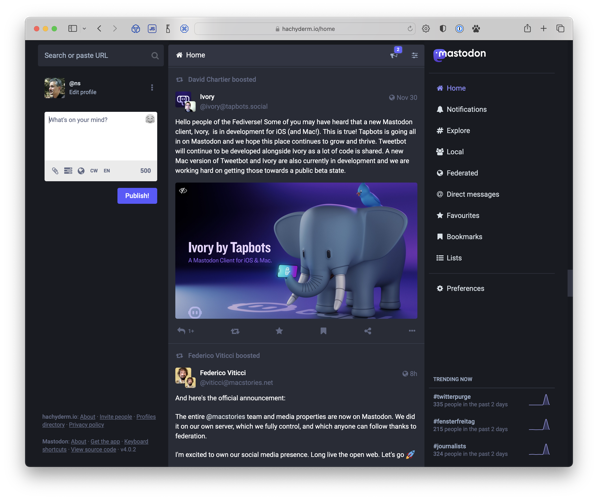This is a very short primer for people who want to move from Twitter to Mastodon.
For most users Mastodon works a lot like Twitter. You sign up, and start using it. You can follow people and be followed. You can post (tweet), you can “boost” (re-tweet), and you have a timeline of posts from the people you follow.

The main obstacle that people have when signing up for Mastodon is that the first step is “choosing a server”. That sounds complicated. What does it mean?
Unlike Twitter, Mastodon is not one company or service. There are many Mastodon services. But it doesn’t matter which service you sign up for. Services can communicate with each other. Think about email: you may have Gmail and your friend uses Hotmail, but you can still send email back and forth. It doesn’t matter that you are on two different services. The same is true of Mastodon.
-
Pick a service. I’d recommend one of the bigger ones. The bigger services are more likely to be around for a long time and your posts will have more visibility. Some that are accepting sign-ups are: masto.ai, mas.to, mastodon.world, and universeodon.com.
-
You can use the web site of your chosen service, but you can also use an app. Popular ones are the official Mastodon app, whimsical and reliable Toot! for iPhones, and Tusky for Android.
-
Follow people! Use the search feature to find people by name, or, if you know their Mastodon handle (which looks like this:
@ns@hachyderm.io), enter that in the search box. You can also find the people that you were following on Twitter, on Mastodon. See the section below, Following People from Twitter.
So the short version is: Go to one of the following and sign up:
Then enjoy Mastodon! 🎉 🐘
Technical Notes
Following People from Twitter
You’re not the only one. A lot of people moved from Twitter to Mastodon (hashtag #TwitterMigration). If you were following a bunch of people on Twitter and would like to find them on Mastodon, use Movetodon. This is becoming less effective as Twitter tries to stop people from moving to Mastodon, but for now it still works.
Moving Servers
If you don’t like the server you picked, you can move servers. This capability is built-in to Mastodon, under Preferences → Account.
When you move servers, all of your followers move with you automatically. You can move your followed list too; there’s a nice import/export function for that.
However, your previous posts don’t move.
Picking a Server
Here’s why I said that you should sign up for one of the bigger services.
Besides those services being likely to be around for a long time, another reason is visibility. If you are on a tiny server, no one will see your posts unless they are following you, or someone who follows you “boosts” (re-tweets) your post, or your post is a message to them or a reply to a message in their feed.
Every Mastodon server has a Local Feed that you can view. The Local Feed is everything being posted by the people on that server. By signing up on a popular server, when you post, it will be available on that server’s Local Feed. It’s also a good place to find other users you might want to follow. On a less-popular server, it may be harder for your posts to be noticed and gain traction, if that matters to you.
The other reason is that some servers are known for hosting violent or objectionable content. Many of the mainstream servers block these servers (technical term: they “defederate” from these servers). The mainstream servers are not going to be blocked by other mainstream servers.
With that said, there can be good reasons to pick a specialized server. There are themed servers dedicated to specific communities. For example, if you are an astronomer, you may want to be on astrodon.social. Many of the members are professional or amateur astronomers, and the Local Feed on that server is mostly astronomy-related posts. Of course, you can post about anything, and posts can be viewed by anyone anywhere, but a server built around a specific topic can be a good way to find your community.
There are themed servers for science and technology topics, as well as regional (city/state/country) themed servers, and servers for all kinds of specific communities, such as LGBTQ+, musicians, Etsy sellers, Christians, people with specific health conditions, and so on.
A list of themed servers is at: fediverse.party/en/portal…
Most Mastodon servers list the number of users right on their home page. Beware if the server is very small. It may be run as someone’s hobby and there’s no guarantee it will be around for a long time.
Finally, you may care about how well-run the server is. You don’t want a slow server, or one that is always having technical problems. The Fediverse Observer can reveal whether the server you’re interested in is a dud. For example, this popular server has only a 65% uptime.